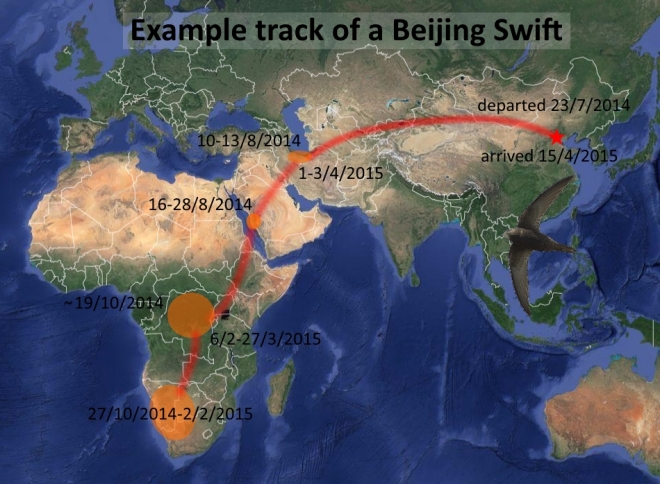 Els ocells han de prendre decisions sobre on construir el seu niu. Sembla clar que els ocells colonials (com els de la fotografia) es veuen atrets per la presencia d’altres individus; però passa el mateix en ocells territorials? Doncs cada vegada hi ha més evidencies que els ocells territorials, a part d’avaluar directament la qualitat de l’hàbitat, també fan servir la presencia d’altres territoris de la mateixa espècie com a font d’informació sobre la idoneïtat d’un lloc per a criar-hi.
Els ocells han de prendre decisions sobre on construir el seu niu. Sembla clar que els ocells colonials (com els de la fotografia) es veuen atrets per la presencia d’altres individus; però passa el mateix en ocells territorials? Doncs cada vegada hi ha més evidencies que els ocells territorials, a part d’avaluar directament la qualitat de l’hàbitat, també fan servir la presencia d’altres territoris de la mateixa espècie com a font d’informació sobre la idoneïtat d’un lloc per a criar-hi.S’han fet experiments on es posen reclams d’ocell i es veu que si els ocells han de seleccionar entre dos llocs equivalents, seleccionen el lloc on hi canta un individu de la seva espècie. Si ho pensem bé, això és el que fem nosaltres: quan estem buscant un bar acostumem a seleccionar aquell on hi ha gent, i som reticents a entrar a un bar buit... fem servir informació social per prendre decisions individuals.

Per tant, mesures de gestió de millora de l’hàbitat per una espècie determinada poden fracassar en espècies que donin molta importància a la informació social (tot i ser espècies territorials). Això no vol dir que no haguem de millorar l’hàbitat, sinó que s’ha de tenir en compte que l’establiment d’una espècie en un lloc es una decisió; un comportament. Per tant, entendre com prenen decisions els individus (estudiant el comportament dels ocells) es un ingredient important a la hora de gestionar les seves poblacions.
> Una revisió sobre el tema: Ahlering, M.A. i Faaborg, J. (2006) Avian habitat management meets conspecific attraction: if you build it, will they come? The Auk 123(2): 301-312.
> Un estudi concret: Nocera, J.J., Forbes, G.J. i Giraldeau, L-A. (2006) Inadvertent social information in breeding site selection of natal dispersing birds. Proceedings of the Royal Society of London B 273: 349-355.
Photo by Scott Henderson (Flickr; Creative Commons)
---------------------------- ESPAÑOL -------------------------------
Ciencia aplicada a la gestión
 Los pájaros deben tomar decisiones sobre dónde construir su nido. Parece claro que los pájaros coloniales (como los de la fotografía) se ven atraídos por la presencia de otros individuos; ¿pero pasa lo mismo con los pájaros territoriales? Cada vez hay más evidencias que los pájaros territoriales, aparte de evaluar directamente la calidad del hábitat, también utilizan la presencia de otros territorios de la misma especie como fuente de información sobre la idoneidad de un lugar para criar.
Los pájaros deben tomar decisiones sobre dónde construir su nido. Parece claro que los pájaros coloniales (como los de la fotografía) se ven atraídos por la presencia de otros individuos; ¿pero pasa lo mismo con los pájaros territoriales? Cada vez hay más evidencias que los pájaros territoriales, aparte de evaluar directamente la calidad del hábitat, también utilizan la presencia de otros territorios de la misma especie como fuente de información sobre la idoneidad de un lugar para criar.Se han hecho experimentos donde se ponen reclamos de pájaro y se ve que si las aves tienen que seleccionar entre dos sitios equivalentes, seleccionan el lugar donde canta un individuo de su especie. Si lo pensamos bien, eso es lo que hacemos nosotros: cuando estamos buscando un bar acostumbramos a seleccionar aquél donde hay gente, y somos reticentes a entrar en un bar vacío... utilizamos información social para tomar decisiones individuales.

Por lo tanto, medidas de gestión de mejora del hábitat para una especie determinada pueden fracasar en especies que den mucha importancia a la información social (a pesar de ser especies territoriales). Eso no quiere decir que no tengamos que mejorar el hábitat, sino que se tiene que tener en cuenta que el establecimiento de una especie en un lugar es una decisión, un comportamiento. Por lo tanto, entender cómo toman decisiones los individuos (estudiando el comportamiento de los pájaros) es un ingrediente importante a la hora de gestionar sus poblaciones.
> Una revisión sobre el tema: Ahlering, M.A. i Faaborg, J. (2006) Avian habitat management meets conspecific attraction: if you build it, will they come? The Auk 123(2): 301-312.
> Un estudio concreto: Nocera, J.J., Forbes, G.J. i Giraldeau, L-A. (2006) Inadvertent social information in breeding site selection of natal dispersing birds. Proceedings of the Royal Society of London B 273: 349-355.
Foto de Scott Henderson (Flickr; Creative Commons)

















































































.jpg)

0 comentarios:
Post a Comment